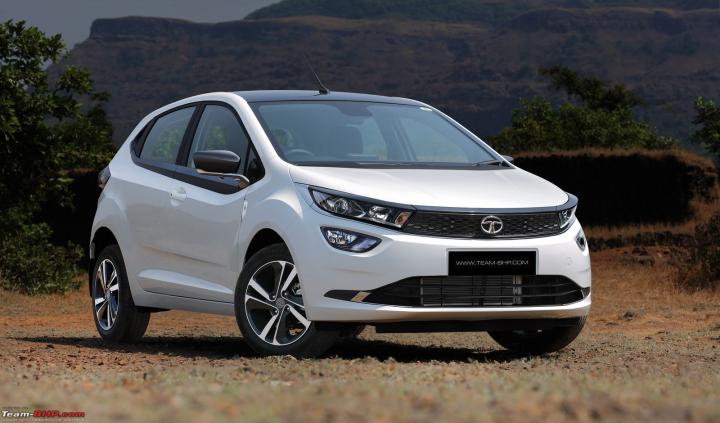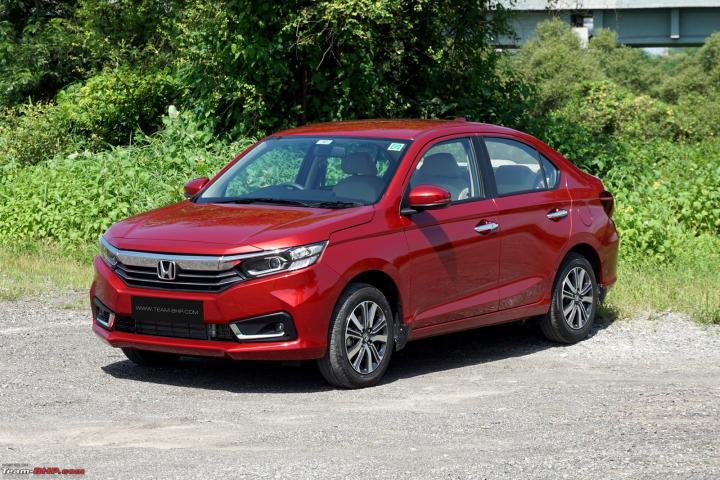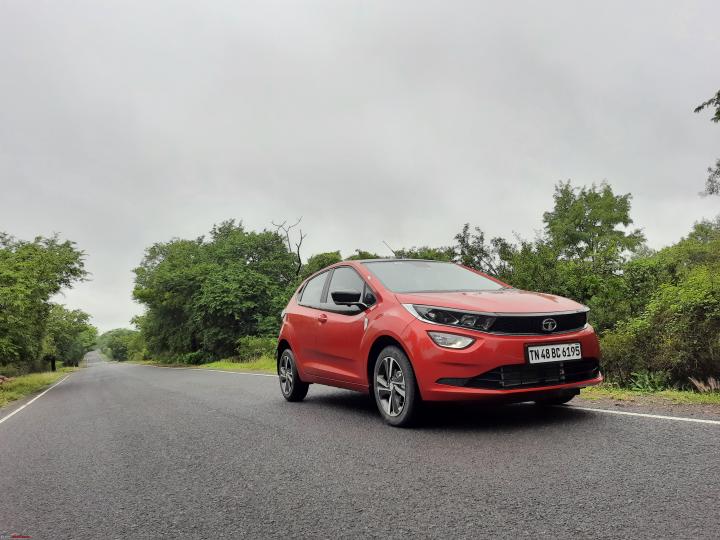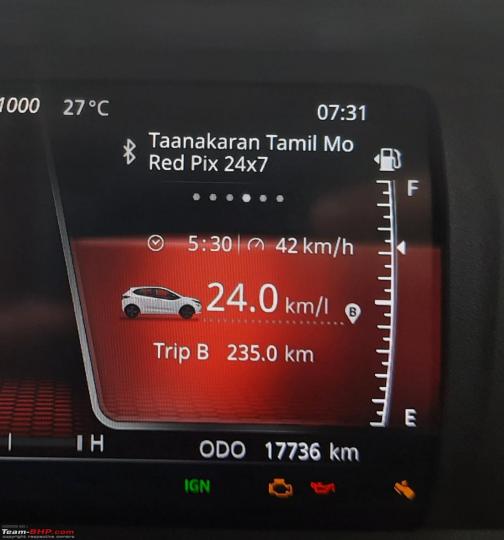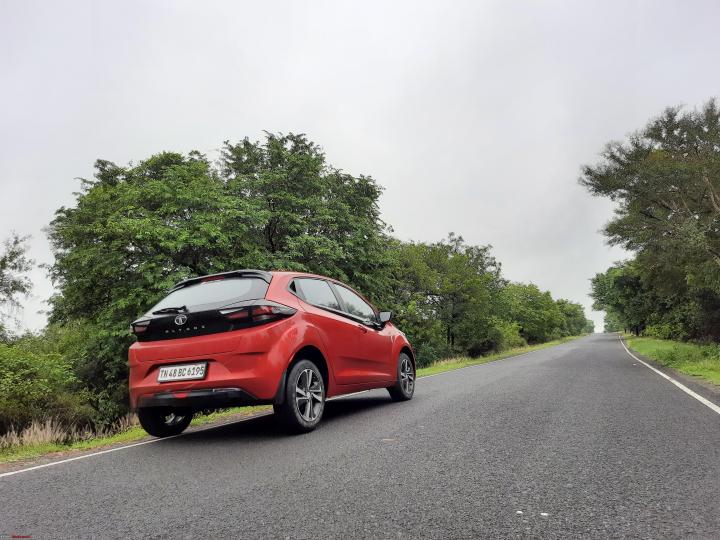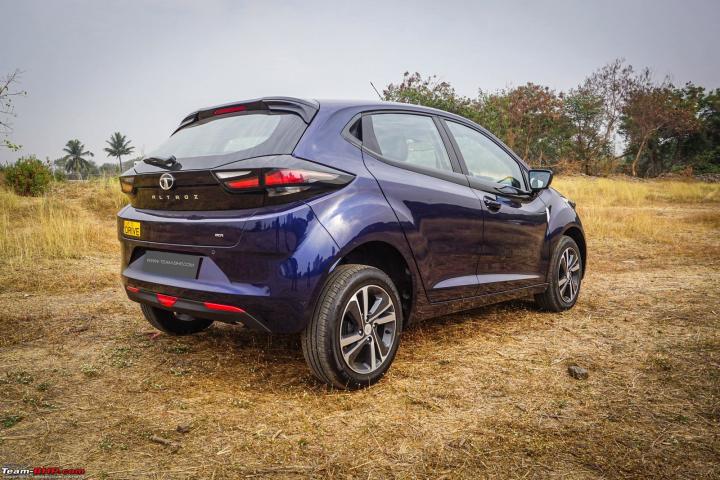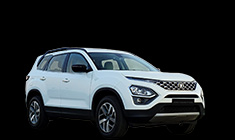News
Tata Altroz select variants discontinued
Tata Motors has re-introduced the High Street Gold exterior colour.
Tata Motors has made some changes to the Altroz line-up. The carmaker has axed variants.
While the Petrol XZA (O) variant has been discontinued, the hatchback is now available in XT Dark Edition trims. As for the diesel variants, the XE, XZ Dark and XZ (O) variants have been discontinued.
Tata Motors has re-introduced the High Street Gold exterior colour. The car is now available in 7 colour options, including Opera Blue, Arcade Grey, Downtown Red, Avenue White, Cosmo Black and Harbour Blue.
The Tata Altroz is available with 1.2-litre petrol, 1.2-litre turbo-petrol and 1.5-litre diesel engine options. A 5-speed manual transmission is standard across the range, while a dual-clutch automatic is available with the naturally aspirated 1.2-litre petrol engine.
- Tags:
- Indian
- Tata Altroz
- Altroz
- Discontinued
News
Advice needed: An easy-to-drive automatic car under 10L
Primary contenders are the Tata Altroz DCA and Honda Amaze CVT.
BHPian dvasudreddy recently shared this with other enthusiasts.
Hello all, this is my first in this amazing forum. From the forum threads and comments, I came to the understanding how good this group is.
I'm a 32 year old salaried employee with a wife and a kid of 2 year old. I'm planning to buy a car, my first car. Will all the things to consider around and so many options available in the market, I'm just stumped and unable to decide anything. Let me say my requirements first.
- Budget is 10 lacs with 10% variation on both sides
- It doesn't matter whether it is a sedan, hatchback or compact suv
- Car should be a safe car, and would be used as family car. Since I have no other way of understanding the safety of any car, I am just going by NCAP ratings. Please let me know if that's a wrong approach. And, definitely no to a car with 2 stars or lower ratings.
- My commute is majorly in the city, hence, an automatic. However, once or twice in a quarter I may need to travel on highway ( 450 km one side).
- Mileage is not a major concern for my usage, however, good mileage is definitely an add on.
- Since I will be spending considerable time in the car, good interiors and ride comfort would definitely sway my decision (including good infotainment system)
- I live in Hyderabad, which has many hills and accordingly many roads with considerable slopes. So, is it required to have hill hold control for an automatic. If so, that would also become part of my requirement.
One other thing, I'm a novice driver, well, pretty much basic.
Cars I have considered:
1) Honda Amaze CVT
Why? Honda brand, post sales services, CVT under 10 lacs, smoother and reliable family car (as per reviews), safety ( 4 star ncap rating)
Why not? No hill hold control, poor infotainment system (relatively), poor engine response (as per reviews because of CVT), no cruise control.
2) Altroz DCA
Why? Good looks, good ingress and egress ( i have elderly parents), safety (obviously), good speakers (as per reviews),
Why not? Unreliable post sales services of tata, unproven DCA transmissio in for Tata, no hill hold control
I have only listed those two option as I didn't consider cars with AMT transmission (as they reportedly have not so smooth transmission). If any AMT cars are good, I'm open for them as well. Thought about new Baleno also, but, not so sure about marutis build quality.
Any suggestion would be highly appreciated.
Here's what BHPian SoumenD had to say on the matter:
Amaze CVT should be fine if you are ok with the looks. That 1.2L iVtec CVT combination is ultra smooth and reliable (speaking from personal experience). Being a Honda its fill it,shut, forget it kinda car. And unlike Maruti/Hyundai at least honda didn’t go too stingy by providing a compromised bodyshell. This one does well with a 4* GNCAP.
While I am a staunch supporter of TATAs for their impeccable 5* safety build, would be a bit wary of the DCA which is relatively new. Maybe if we have some owners of the model on forum, they can throw some light?
Btw if I were you, in this budget would also consider Nissan Magnite. That’s another rare 4* rated car(with stable bodyshell) and has a more powerful 1.0L turbo CVT which would be a better performer . Yes the interior quality is a bit underwhelming but do give it a look(& test drive).
Here's what BHPian rishi.roger had to say on the matter:
AMTs are not horrible, atleast not the recent ones. However they are not that smooth either. You will feel slight jerk/lag when the gear shifts. Its annonying initially if you have experienced anything like CVTs before, however you get used to AMTs over time and learn how to push the gas pedal to reduce that jerkiness.
AMTs are cheaper to maintain, they also allow some level of manual control (most AMT cars have a manual mode..which is not exactly a 100% manual as you can control the upshift but downshift may still happen automatically).Unfortunately most cars under 10L come with AMT as it reduces the cost of building for manufacturer.
Honda Amaze and Nissan Magnite are the two good picks anyday if you want the joy of automatics. Nissan's automatic is really good. If you want to spend a little more then can look for Venue Turbo Automatic which in my opinion is a good Car.
I like what Tata offers for money, particularly safety and build rigidity. However do check out if their refinement, fit and finishing suits you. You may notice gaps in paintwork, panel fitment, rubber sealing/gaskets, and higher NVH levels comparatively.
Here's what BHPian shancz had to say on the matter:
Since you're a new driver I would suggest to take a TD and then think about whether any car has enough power or not since this is quite subjective.
I agree with going for a proper automatic but your budget limits your options severely and so does the GNCAP rating. To provide you with some options I am skipping the GNCAP part which you can apply once you have taken some TDs and shortlisted.
Some suggestions for TD, not in order :
- Altroz DCA : already mentioned in OP
- i20 Sportz 1.2 IVT : 1.2 NA with CVT, no GNCAP rating
- Amaze : only concern would be the reports of quality issues like rusting doors as reported by members.
- Baleno AMT : Just to experience the AMT
Outside of these and if you prefer, check if you can get your hands on the previous gen Brezza AT or the Toyota Urban Cruiser which is still based on the previous gen Brezza so priced better and probably the mid variant can fit. GNCAP 4 stars but the interiors would look dated and the audio quality is no match to the Altroz though.
Here's what BHPian ajayc123 had to say on the matter:
Slightly against one of your constraints, but just one suggestion. For your first car, I could suggest you to think about MT, as it will remove your hesitancy of handling manual for the rest of your life. With that said, Brezza MT entry level could be within your budget, if you wish to consider.
Read BHPian comments for more insights and information.
News
My Altroz RPM skyrockets on its own; Engine fails in a cloud of smoke
After a month of servicing, the car is now again ready to be delivered.
BHPian jomgeorge recently shared this with other enthusiasts.
We have a Tata Altroz Diesel BS6 that is 5 months old and has covered 12,830 kilometres. One day while me a 12th-grade student, my elder brother, who is a second-year undergrad, and my younger sister, who is in the tenth grade were travelling in this car through a two-lane highway at around 70 Km/Hr. After roughly 30 kilometres, all of a sudden with a loud blasting sound the car's RPM skyrocketed and went inordinately high, well beyond the limits of the tachometer, with a significant volume of white smoke expelled from the silencer. Everything happened on its own and it was inevitable. We had no control over it. Before we could park the car, it shut off on its own, leaving us with no brakes. The rise in RPM resulted in an increase in acceleration, but owing to timely intervention and luck, we were able to park the car using only the hand brakes. The amount of smoke released by the car in such a short time was more than enough to engulf the entire highway and its environs in smoke. If a car had approached from behind, he would have been in serious peril as well. Fortunately, all of this occurred on a less traffic day, which meant that a multi-vehicle catastrophe was averted. I also discovered that the engine oil was almost an inch above the maximum level. This might be the result of the occurrence. When I tried to start the car later, it wouldn't, so a recovery vehicle was called. Even the RSA was not responding and had to wait 4 hours waiting for someone to arrange a Recovery vehicle
Due to my dread of death that day, I investigated this thoroughly even during my exam days and realised that the condition was strikingly similar to a Diesel Engine Runaway. And in that situation, if the engine dies before we can stop it, the engine has unquestionably failed catastrophically. For those who are unfamiliar with diesel engine runaways, I've included a link to a Team-BHP page where you may learn more.
The service centre had no idea what had transpired, and it was their first time dealing with a situation like this. They further asked at every Tata service centre in Kerala to see whether any similar incidents had ever been reported. However, there was none. All of this occurred, according to the service centre's account on behalf of the Tata technical team, due to an excessive flow of fuel through all injectors. All of the injectors were determined to be defective and clogged. I was curious as to how all of the injectors could fail at the same time and cause a fuel overflow. After further investigation, they discovered that the cylinder and pistons had been damaged, necessitating the replacement of the whole engine assembly. Beyond that, they had to replace all four fuel injectors, fuel pump, turbo and catalytic converter.
I questioned them about the car based on the information I acquired from my research in order to assure our continued prosperity while driving the car, and they frequently had no suitable responses and were ignorant of such possibilities at the time of inquiry. They just stated that various components had been changed, without explaining why. They changed the engine on their own before informing anyone.
The car was ready to be delivered after a few weeks, and I went there a week later to inspect it. I started the car, and when I turned the steering wheel slightly, I heard a lot of creaking, rattling, and grinding noises, which eventually became a knocking noise at one point. After we started the car, it also emitted a foul stench, which they had answers to why it happened. The car was then returned to be repaired. They informed me the next day that the noise from the steering wheel was because of leaving the car unused for a week. I was wondering whether leaving the car unused for a week would cause such a loud noise.
However, I'm glad we're still alive to report this. After a month of servicing, the car is now again ready to be delivered. I just wanted to verify Tata's rationale before getting the car back. Can any other parts be damaged except the ones they've replaced? Like the alternator compressor and other components that are all driven by the engine RPM? It would be much better if others who are more knowledgeable about this one-of-a-kind scenario could offer their knowledge. Should I inspect anything in particular before getting the car?



Here's what BHPian vishy76 had to say on the matter:
This incident is bizarre, but not unexpected. I remember another gentleman on the forum reporting an issue with his injectors and also claiming that a certain batch of Altroz diesel has defective injectors. This is the link IIRC.
I believe what has happened here is the same. The injectors have basically stuck open. Instead of spraying a fine mist of highly atomised diesel in the combustion chamber, the injectors would spray blobs of fuel in huge quantities. This increased fuel flow leads to a rise in RPMs. Apart from leading to a rise in engine speed, this also causes oil dilution.
During the compression stroke, when the piston moves upwards, the diesel which isn't atomised correctly doesn't burn completely and the piston ends up compressing liquid diesel. Under pressure, the liquid forces its way past the piston rings below and into the oil sump, thus diluting the oil. This explains why you saw the oil level beyond the full mark on the dipstick. Oil dilution is a dangerous phenomenon. If left unresolved, the diesel present in the oil will portray detergent properties and start washing the oil off from engine components such as bearings. It will effectively negate the lubricating properties of the oil.
If the entire engine assembly has been replaced, I wouldn't worry much TBH. Parts like the alternator and compressor can be left alone. I just hope a pre-assembled engine was put into your car, and not some sort of a "half-job" where the service centre reused some of the older engine internals.
Check out BHPian comments for more insights and information.
- Tags:
- Indian
- Altroz
- Engine Issues
News
Fixing all niggles on my Tata Altroz diesel: 15,000 km update
The Altroz has returned an average fuel efficiency of 21 km/l on long trips and is a great mile-muncher.
BHPian aswin ajith recently shared this with other enthusiasts.
Hi folks,
Posting this for the benefit of existing and prospective owners on this forum and also because I am unable to find time to put together an ownership report, my Altroz D has completed 15,000 km. I just back from service and all is well.
This post is just to point out something which I faced on my recent run from Bangalore to Kochi. I will post a video of the instrument cluster for better understanding.
As you can see, the instrument cluster started acting all weird and at the same time, I noticed the car went into the limp home mode with the throttle cutting off at 2000 rpm. Since this happened in the early hours of a Sunday and I was with family, I had no choice but to keep driving.
After a while, I restarted the car at the next toll plaza stop and the cluster just completely froze, except for the fuel gauge and clock. No warning lights no speedo and tacho and no trip computer as well, everything just went blank. I also noticed cruise control wasn't available.
Dropped the car in for 15,000 km service at Gokulam Motors Kochi yesterday morning. I was told that the ECU software was buggy and reflashing it to the latest version (AL04) solved the issue. Took an extended test drive afterwards and found out that there were no issues.
Apart from this, the battery just drained all of a sudden couple of months back and for the life of me, I was never able to figure out why. Charged it again and I faced no other issues.
Apart from the above mentioned two niggles the car has been driving like a dream. It's such an amazing mile-munching machine. I have already done three 2,500 km road trips across South India and its been such a hoot to drive. The fuel economy has also been nothing short of amazing and I have been managing a consistent 21 km/l on these long trips. I am not a sedate driver.
So far I have been getting amazing support from the folks at Gokulam Kochi with special mention to my SA Vishnu. Tata owners in Kochi, I highly recommend this guy and you can give my reference.
Posing right after 15,000 km on the clock. Ready for another 15,000 km as well.
Check out BHPian comments for more insights and information.
News
Steering pulling to the left on Tata cars: A common issue with no fix?
They claim that steering recalibration can be done easily on BS4 vehicles (Nexon) but not on BS6. Is this true?
BHPian NvrGivUp recently shared this with other enthusiasts.
I got the Nexon XZA+ P in Feb 2021 and there is a slight pulling to the left from the very beginning. Had been raising this concern in all three services and yet the problem is not resolved. Recently I took my vehicle specifically to get it fixed. I did my due diligence to find out the potential root cause and what I found out was that the steering recalibration could resolve this issue. I told this to the service advisor and they inspected the vehicle. Confirmed the LHS pulling even after alignment was done but they cannot carry out recalibration on Nexon BS6 until some warning light throws up. They claim that steering recalibration can be done easily on BS4 vehicles (Nexon) but not on BS6. Is this true? What I came to know that is the service technician is not able to proceed with steering recalibration as there is a question that asks " if there is a steering warning light showing up?" and if the answer is NO, then recalibration cannot be done.
Not sure why they can't select "yes" and proceed with recalibration. Also, can the recalibration be done easily or does it involve risking the airbag sensor set up (as claimed by the SA)? Can anyone please confirm or help out to fix the issue? Do I have to raise it to customer care? Most probably they will divert it back to the last service centre where I got my vehicle checked.
I have left my vehicle with the service centre for resolving the issue. Keeping my fingers crossed.
Update: I was asked to pick up the vehicle on Thursday telling me that it was all fixed. It was just a gimmick. It was in the same condition as the previous day. They checked the wheel alignment again in my presence on Thursday and I must admit that it has improved a little bit but the original problem is still there. Since I had plans to go on a long trip, I took the vehicle and told them that I will bring the vehicle later.
BHPian SomanshuK also shared a similar story on his Tata Altroz diesel.
My engine oil had severely degraded, even before 7500 km on the odometer. I asked them to replace it, even when the manual recommends a change at 15k km. On asking the reasons for early degradation, they replied that the factory ECU settings were such that injectors were throwing in too much fuel which got mixed with the engine oil and hence, degraded the quality.
I don’t believe them one bit because I had got the ECU update done on the first (1k km) service, on their recommendation. I had asked them, back then, to check if fuel was mixing with engine oil, to which they replied, after inspection, that it was not the case, and it won’t happen now since they had upgraded the latest ECU update. Now on the second service, their reply was just to answer my query, technical considerations are damned.
Just to emphasize, on the first service, I had asked them to do the ECU update, which they didn’t first and just sent out the vehicle with the job card closed. When I asked before leaving if they had done it, they admitted that they had forgotten it but will do it now. Such a waste of my time!
So, the steering issue remains unresolved, as ever, and I don’t have the patience to follow up on everything with incompetent professionals. When you are paying for something, you expect some quality in service. Here, I have to fight for basic issues with TASS staff. Deep within, I am so frustrated that I think, if they try to resolve the problems, they will create more issues than fix one.
XZ+ comes equipped with cruise control, which I use extensively while doing long 12-hour runs. But my right shoulder blade pains because of holding the steering for long hours to keep the vehicle straight. The left drift isn’t much, but it is noticeable.
All said and done, the vehicle is great, the diesel engine is sufficiently powered and the ride quality and seating comfort (front seats) are great too. It's just the service I am disappointed with. Planning to take it to MRF’s alignment facility and get it checked, something which TASS should have already taken care of.
I have read numerous posts stating this problem in various models, Safari, Harrier, and Nexon alike. I don’t understand why the company does not do something about it.
Also, just to add a bit of info to address the concerns of prospective buyers of Tata’s BS6 diesel, I have not had any DPF issues until now, 10k km done. Although my runs are mostly (>80%) highways, the high revs, raise the temperature enough to keep the filter clean, which may be a problem with city commuters. My brother has had these issues in BS6 diesel Seltos thrice, at just 5500kms with 100% city runs, in Kanpur, where high traffic volume does not allow shifting beyond the second motor. Even a BS6 diesel Innova in the family reported DPF to check light with mostly city-runs in Delhi.
At least I haven’t faced any DPF issues yet, which is a greater concern, thanks to the incompetence meted out by service station staff (including service advisors).
People who have had this steering issue resolved successfully, may pls advise fellow BHPians on how to proceed with the issue!
Another BHPian maddyg also shared this about the Tata Harrier.
I have a 2021 May manufactured XT+. Recently noticed that there is a slight amount of steering vibration between 105-120 Kmph. Below and above it feels normal. The said vibration is only felt when the steering is held very lightly, with one hand without holding tight. With both hands on the wheel, it's barely perceivable. Checked this on a long highway drive, behaviour is consistent.
Haven't noticed this till I got the alignment done at 5k, could be due to the fact that the only long long run till then was in the running-in period and did not attempt much 100+. A major reason for alignment was left pull, which is still present though slightly less in nature. Alignment was performed outside, not at the ASC.
The second service is scheduled this weekend, wondering should I report the above behaviour at ASC and demand a solution (don't want to get it to worsen though). Has anyone else noticed something similar?
Check out BHPian comments for more insights and information.
News
Surprising fuel efficiency from a 18,000 km run Altroz: 700km on 1 tank
The fuel efficiency allowed for an impressive 700 km range from the car's small 35-litre tank.
BHPian PrasannaDhana recently shared this with other enthusiasts.
Reporting the best tankful-to-tankful fuel efficiency of my 18,000 km run Altroz diesel
23.87 km/l
100% AC ON, 2 occupants - 60% Highway : 30% Rural areas : 10% city
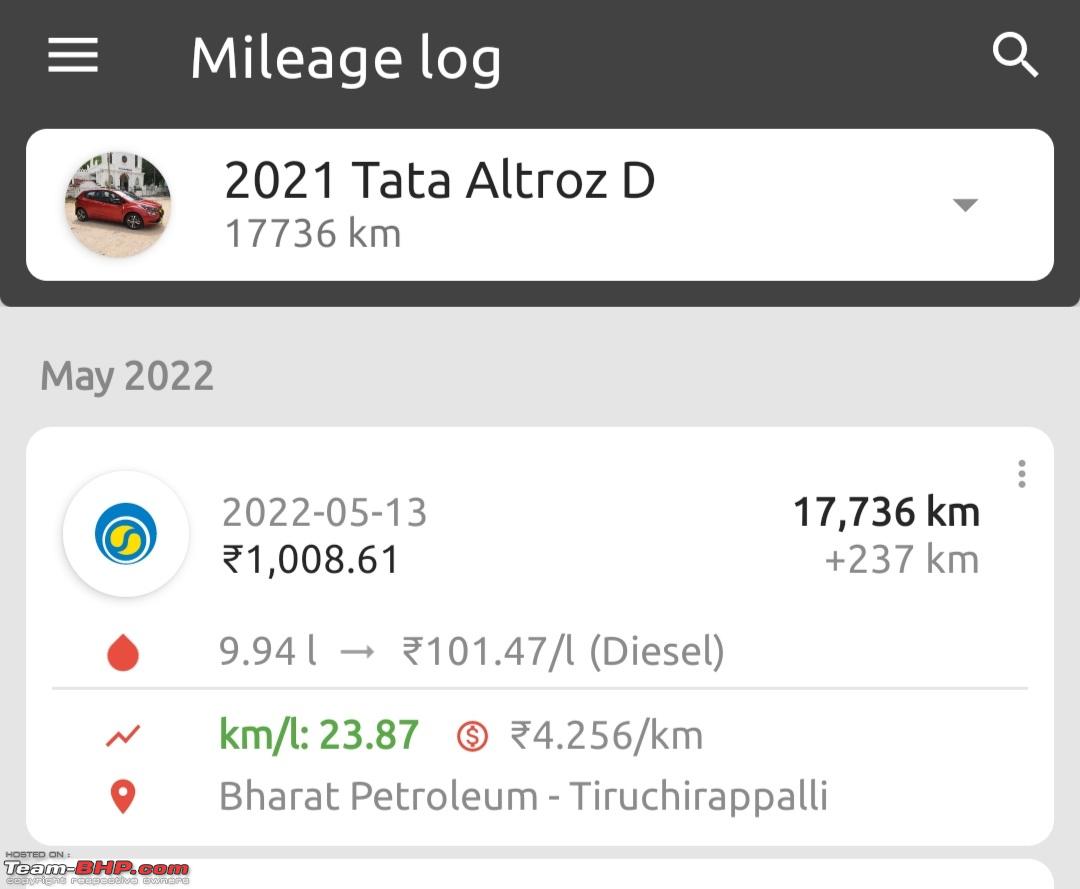
Surprisingly the MID was not far off

Quite nice to see an almost 700 km range from a small 35-litre tank
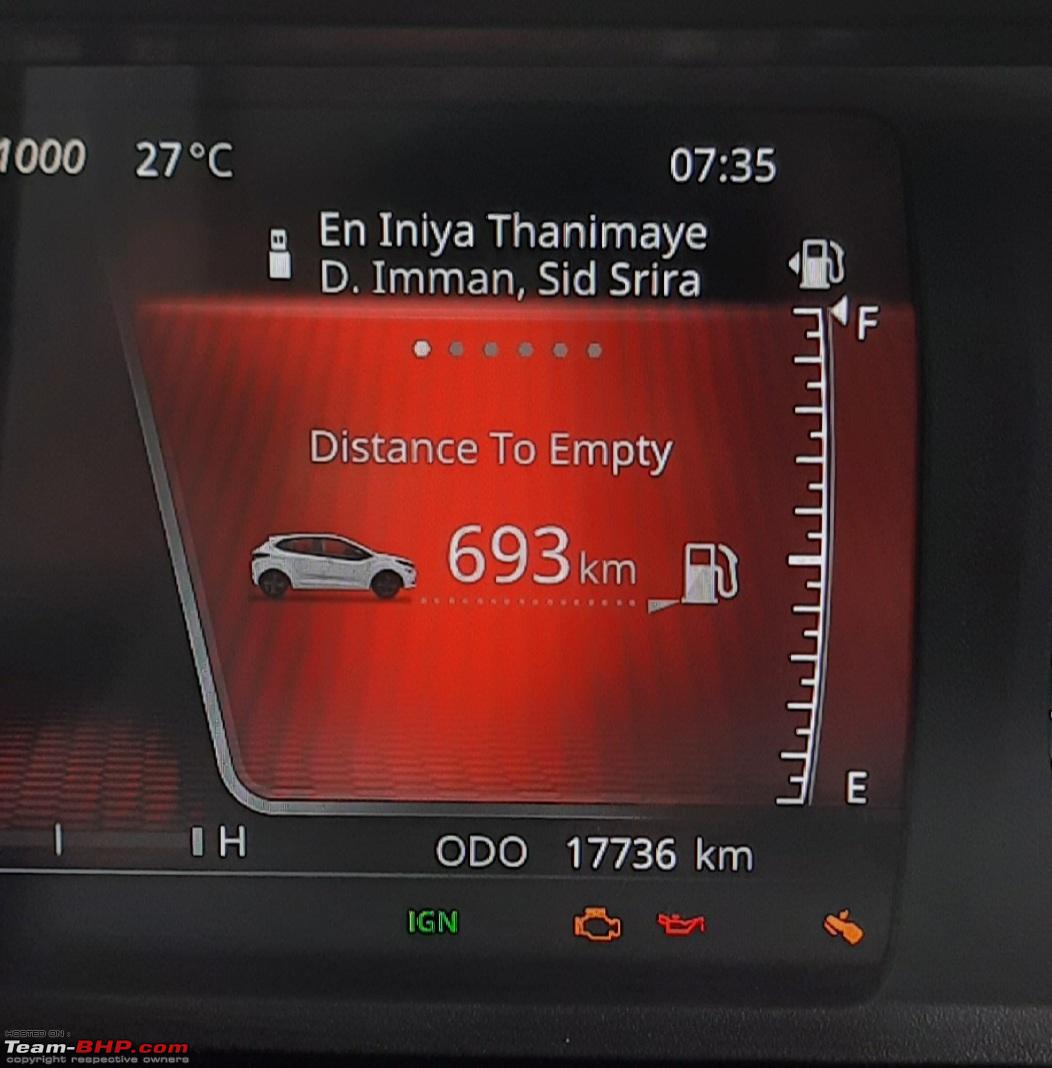
For the readers who are curious about the overall actual fuel efficiency for the entire ~18,000 km
It is 18.37 km/l
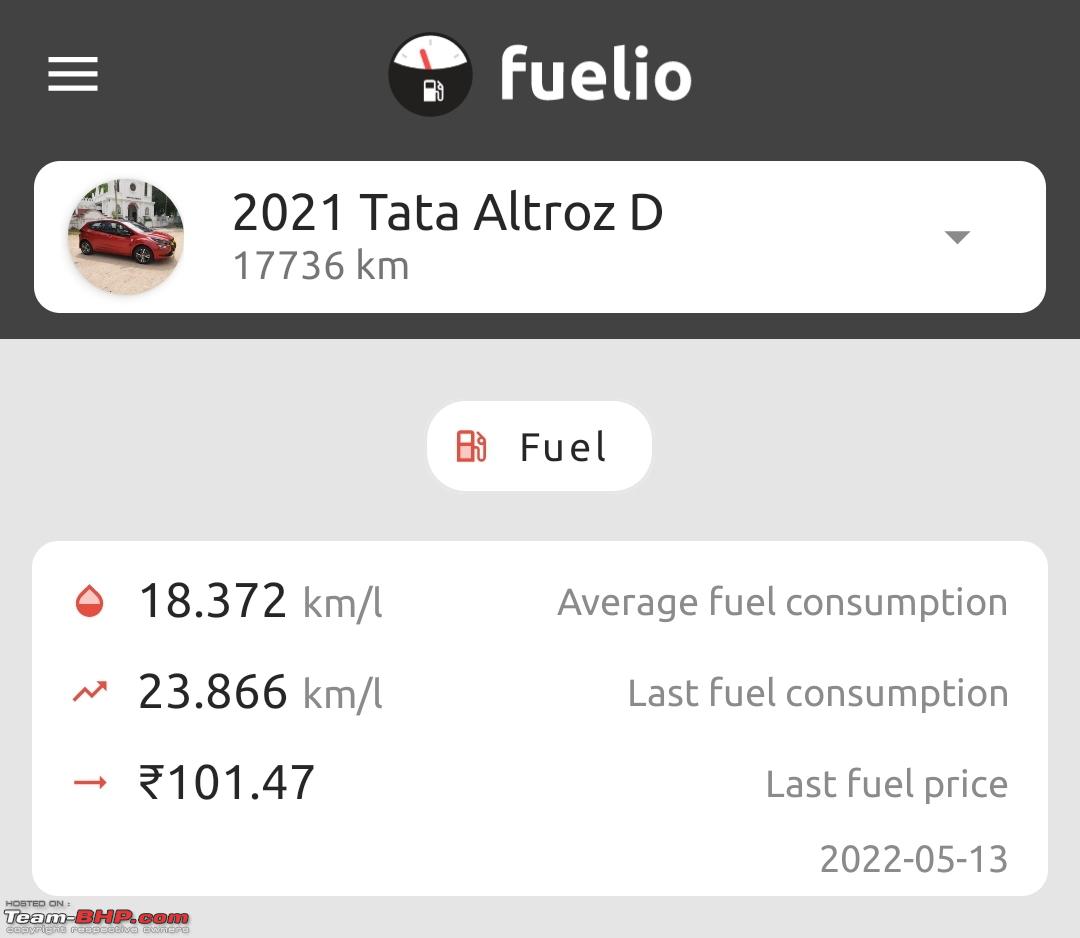
PS: I was very gentle with the A pedal during the last run which yielded 23.87 km/l. Consistently driving the BS6 diesel that way will end up in a clogged BS6 filter within 2000 km
What actual fuel efficiency can a potential Altroz diesel buyer realistically expect: 16 - 19 km/l overall, even if you are an aggressive driver.
Check out BHPian comments for more insights and information.
News
Tata Altroz: Petrol DCA vs i-Turbo vs Diesel | Which to choose?
Tata recently introduced an automatic transmission with its 1.2-litre petrol engine, available on the higher trims.
Tata Motors launched the Altroz premium hatchback in India a couple of years back. Since it went on sale the hatchback has received a few updates last year, including the addition of a new turbo-petrol engine and more recently the addition of a brand new automatic transmission system.
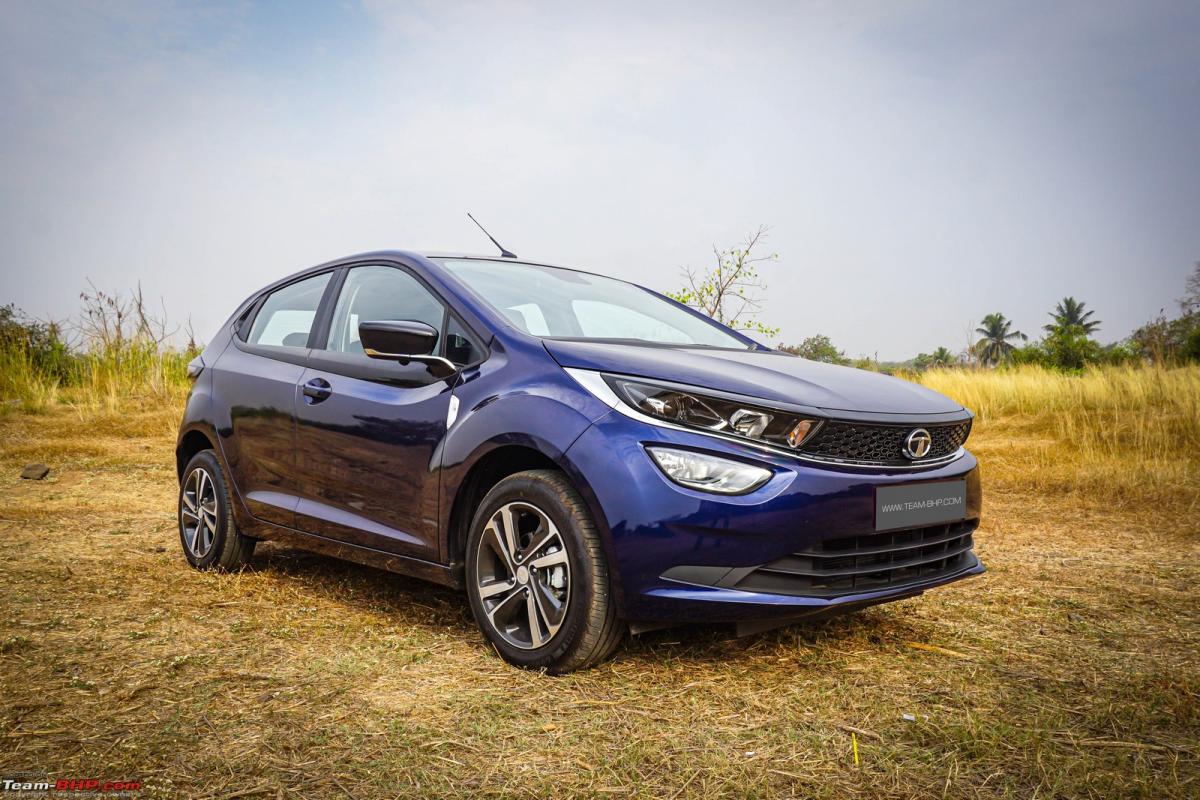
The 2022 Altroz premium hatchback now comes with a range of engine options, including two petrol and one diesel unit. While all three are offered with a standard manual gearbox, the base 1.2L NA petrol now comes with the brand's all-new DCA (Dual-Clutch Automatic) transmission as optional on the higher trims.
So, if you were to buy the Tata Altroz, which engine option would you pick & why?

Starting with the petrol versions, the Tata Altroz is offered with two petrol engines. The first is a 1.2-litre NA petrol engine producing 86 BHP @ 6000 rpm and 113 Nm @ 3300 rpm. The engine is paired with either a 5-speed manual or a 6-speed DCA transmission option.
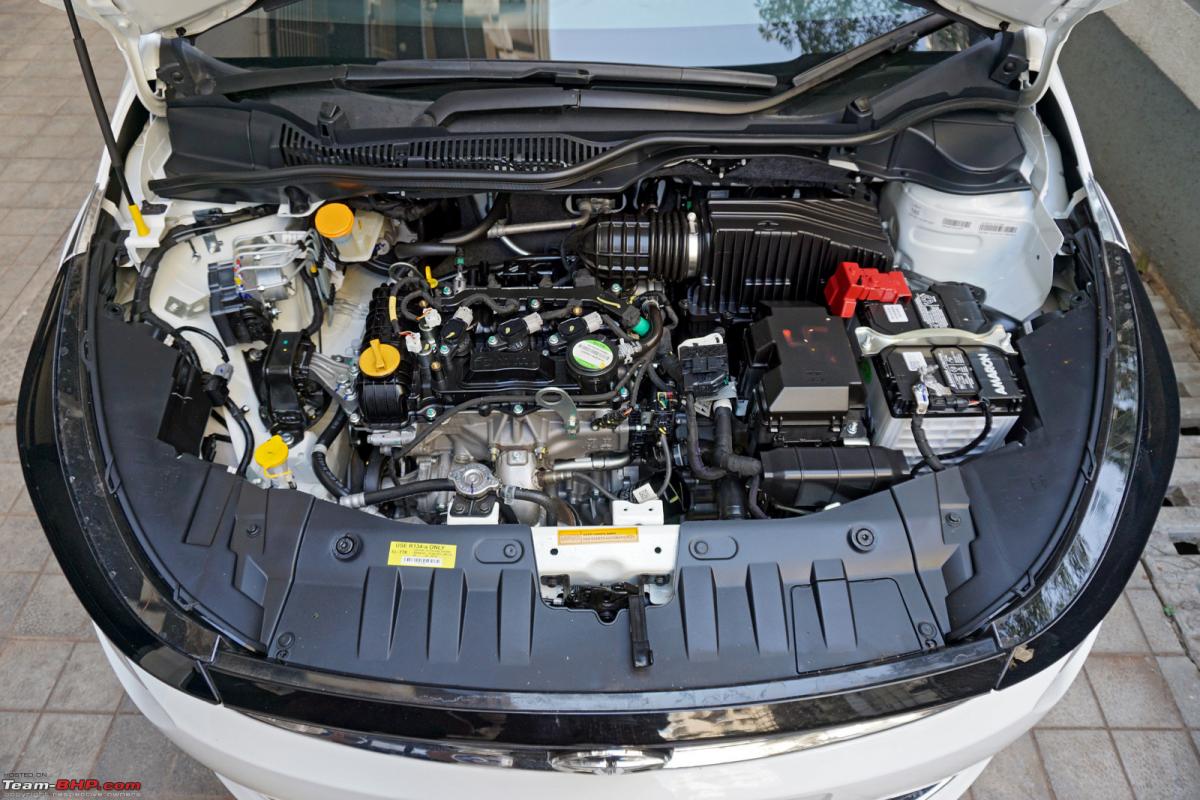
Tata Altroz 1.2L Petrol MT
Over & above the weak power delivery of this motor, what also blunts its performance is the car's kerb weight. When driving around in the city, the Altroz doesn't feel energetic like the Baleno. Power on tap is strictly "adequate". The talking point is its driveability, not power. You can easily potter around in 3rd gear at 40 km/h with the engine revving at ~1,750 rpm. Make no mistake = it has enough poke to carry you around town with few gear changes, albeit in a relaxed manner.
Highway performance is rather ordinary; on the open road, you'll need to work the engine hard to get any kind of pep out of it. Problem is, there isn't much "go" even when you do, hence we suggest you move out of the fast lane and stick to the middle ones. The engine starts losing steam beyond 5,000 rpm and it gets quite vocal too.
Read the full review here.

Tata Altroz 1.2L Petrol DCA
The Altroz DCA is more of a cruiser on the expressway than an outright performer. It can cruise at 100 km/h in 6th gear with the tachometer reading ~2,500 rpm and at 120 km/h, the engine spins at just under 3,000 rpm. You will keep up with 100 km/h traffic on the expressway, although you will be working the engine hard. Floor the pedal and the DCT willingly takes the engine to 6,000 rpm (although we wish there were more revs to play with). Compared to the MT in which you have to vigorously work the shifter & clutch, here, the dual-clutch AT does all the hard work for you.
From a relaxed driver's perspective, the AT is well-matched to the engine. It's smooth & the response times are acceptable in most driving conditions.
Read the full review here.

Tata Altroz 1.2L Turbo-Petrol MT
The Altroz also comes with a 1.2-litre turbo-petrol unit which churns out 110 BHP @ 5500 rpm and 140 Nm @ 1500 - 5000 rpm and is paired with a 5-speed manual gearbox as standard.
In the city, the turbo-petrol variant has very good driveability. You won’t be using the gearbox excessively. It even cleared our 2nd gear speed breaker test easily. There is very little turbo lag. Throttle response is satisfactory and the car has no problem picking up speed from low revs. The healthy bottom-end makes the turbo-petrol Altroz an easy car to drive in the city.
The Altroz turbo-petrol cruises effortlessly on the highway. 100 km/h in 5th gear is seen at ~2,300 rpm, while 120 km/h is seen at ~2,800 rpm. High-speed stability is very impressive and you can calmly cruise at 120 km/h all day long. Solid, planted & confidence-inspiring is how I'd describe it. The steering also weighs up well at speed. Must say that Tata tunes its EPS better than HPS (hydraulic).
Read the full review here.
Tata Altroz 1.5L Diesel MT
The diesel version, on the other hand, comes in the form of a 1.5-litre unit producing 90 BHP @ 4000 rpm and 200 Nm @ 1250 - 3000 rpm. It is mated with a standard 5-speed manual transmission.
From idling revs & when you are just starting off from 0 km/h, the rpm needle takes its own sweet time to climb. While this isn’t an issue in regular driving, it will catch you out on stop-and-go inclines. If you stop in the middle of even a medium-level slope, you have to use the handbrake before getting going again, as it takes a lot of time for the revs to build up again. The throttle response from idling rpm is painfully dull. The turbo-diesel wakes up at ~1,500 rpm and is in its element as you near 2,000 rpm.
The best part about the Altroz diesel is the mid-range. Enjoy it and shift up at 4,100 rpm tops. The only times I pushed it beyond 4,300 rpm was when I was in the middle of an overtaking manoeuvre & needed those extra revs.
I will say that the engine sound is well-controlled. You can hear the diesel at 3,000 rpm, yet it is not loud/groaning/ugly at all. I actually liked the engine note & consider this to be one of the better sounding diesel.
Read the full review here.

Here's what GTO had to say on the matter:
The Altroz 1.5L Diesel is perhaps the best diesel hatchback on sale in India. I'd buy it even over the i20 Diesel, my earlier favourite. That engine + mature suspension + build + styling + 5 star safety make it an all-rounder.
However, I don't need a diesel as my urban running is low (thanks to all the test-drive cars) and I have other highway cruisers. If I buy an Altroz, it will purely be as a local city runabout and hence, it will be the competent in the city (but slow on the highway) Altroz DCA.
Here's what BHPian aquavivarium had to say on the matter:
Altroz diesel is the perfect city car, it's a driver's delight, city commuter and five stars safe.
There is no car in that segment which compares, sad Delhi NCR people shy away due to the 10-year diesel car life.
I would say with just two people you can take it on a trip around India. Feel the 1.5 diesel power and high power to weight ratio.
Here's what BHPian Small Bot had to say on the matter:
Voted for Altroz iTurbo MT as that makes the most sense for my requirements.
While Altroz diesel is by all accounts very impressive, I'll probably go nuts dealing with DPF issues with my frequent nasty-traffic daily runs. And I do not want to do an unnecessary frequent highway run or visit the local Tata ASS just to avoid it.
i-turbo seems ideal to me in terms of the power vs use-case balance.
Here's what BHPian Reinhard had to say on the matter:
I voted for the diesel Altroz too. It's a fantastic engine + chassis combination. True compact cruiser. Will just go on and on - on the straights as well as in the ghats. What a shame that we have hardly any diesel hatchbacks now, let alone fun to drive and safe ones. Altroz shines as one of the few stars. Sadly the sudden downturn in diesel sales means we will probably never see an AT Altroz. If there was one - I'd have replaced my Alto by now. The DCT NA somehow doesn't tick the right boxes for now given my existing garage.
Check out BHPian comments for more insights and information.
- Tags:
- Indian
- Altroz
- Best engine
News
Tata Altroz EV spied; launch soon?
Tata Motors is gearing up to unveil a new electric car on April 29. There's a chance that it could be the Altroz EV.
The Tata Altroz EV has been caught testing once again. This time, the electric hatchback was spotted on NH 48.
The Altroz EV is expected to use Tata's Ziptron powertrain similar to the Nexon EV and Tigor EV. In its current form, it offers a range of around 300 km on a single charge.
Tata Motors is working on a long-range version of the Nexon EV featuring a 40 kWh battery pack with a maximum range of more than 400 km. This could also be offered in the Altroz EV.
Now, Tata Motors is gearing up to unveil a new electric car on April 29. We still don't know what it is, but there's a chance that it could be the Altroz EV.
Thanks to BHPian virajmore03 for sharing this image with other enthusiasts!
News
Received my Tata Altroz with over-filled oil: Could it cause an issue?
Oil has never been changed. Tata recommends oil change @ 15k km. Mine is at 14k.
BHPian Sameer016 recently shared this with other enthusiasts.
I checked the oil level in my diesel Altroz and found it to be quite high. Take a look
Before starting
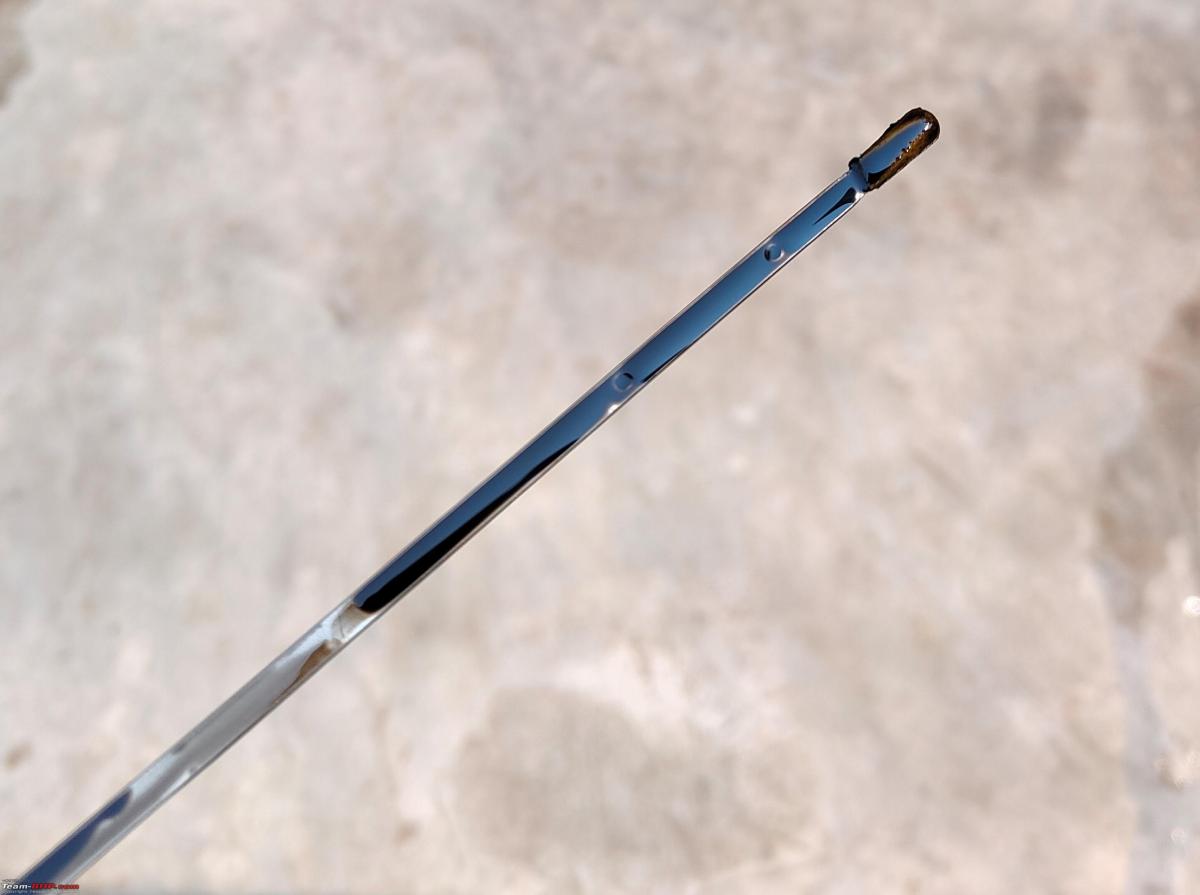
After idling for 1 min

This was the level after sitting idle for the whole night.

Oil has never been changed. TATA recommends oil change @ 15k. Mine is at 14k.
I followed the same procedure and this is the oil level.

Here's what BHPian ph03n!x had to say on the matter:
Ignore the "after starting". But when the engine is cold/ off for like 30 min, check the level like this:
- Take out the dipstick
- Wipe it with a clean cloth
- Dip and fix it in position
- Check the level
If it's still high, TASS overfilled the oil, get them to drain it to max level.
Overfilling oil can cause quite an issue in some engines - I don't know about the 1.5D of Tata though.
Better take it in, do the 15k service now and make sure it's filled right. The 15k km interval maybe the recommended, but if you intend to keep the car for a while, do it at at least 7.5k!
Here's what BHPian Kosfactor had to say on the matter:
Overfilling vs Diesel in Oil sump - nevertheless, please get it checked at the ASC and document it in your job card.
Check out BHPian comments for more insights and information.
- Tags:
- Indian
- engine oil
- Altroz
News
Tata Altroz DCA 2022: Our observations after a day of driving
Tata knows the 1.2L NA engine is weak and has smartly tuned the transmission to extract maximum performance out of it. In that sense, the dual-clutch AT is well-integrated.
Driving the Tata Altroz 1.2L Petrol Dual-Clutch AT
1.2L naturally-aspirated petrol motor puts out 85 BHP & 113 Nm and is mated to a 6-speed dual-clutch automatic transmission. Given that the NA engine constitutes about 85% of total Altroz sales (as claimed by Tata), Tata has chosen this engine and not the turbo-petrol for the dual-clutch automatic. Of course, it's also down to the price; the turbo-petrol would've made it more expensive:
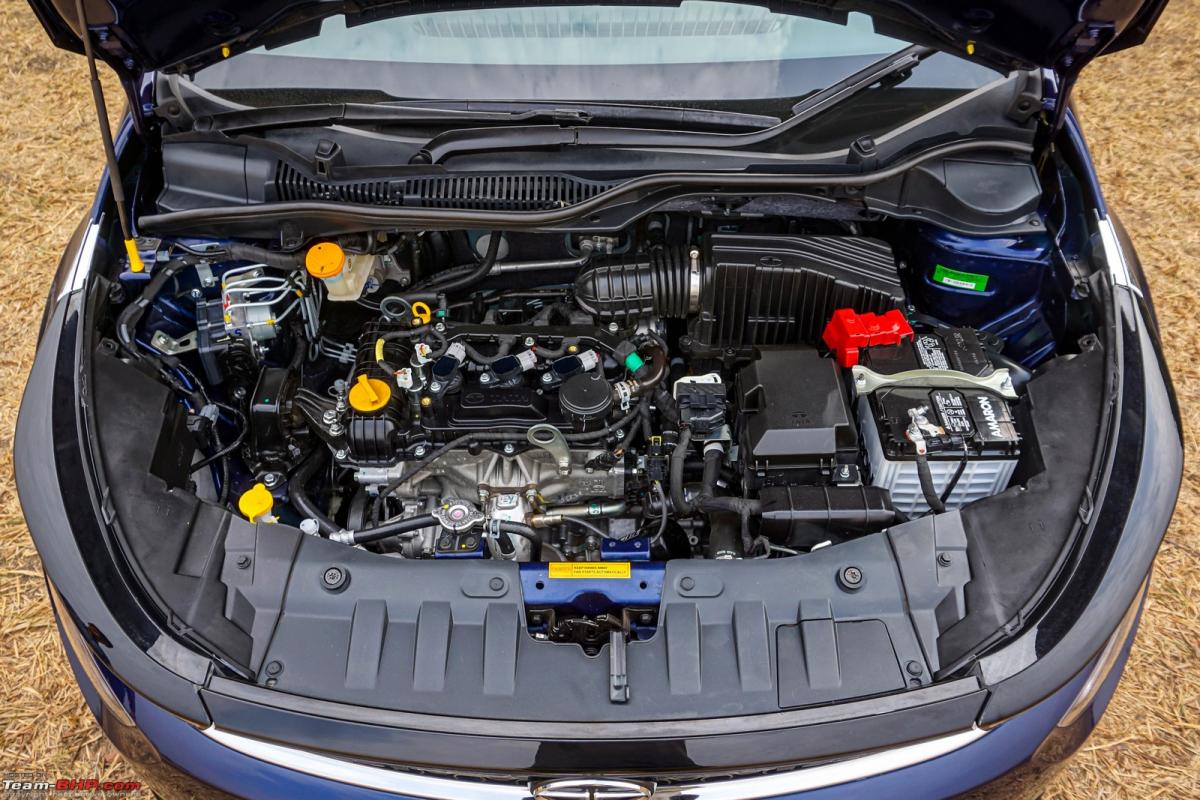
There's been a lot of fuss about why Tata chose the dual-clutch automatic over an AMT (thank God!) or a torque converter. Well, Tata understands that the Indian market is now mature enough to prioritize a smoother driving experience for an additional premium over a jerky AMT. Additionally, dual-clutch ATs are comparatively more fuel-efficient than torque converters and more suitable for cars with low torque. This dual-clutch automatic is the first on a Tata car and comes from a Belgian company named 'Punch Powertrain'. It has been specifically developed for the compact vehicle segment. The 'DT1' gearbox is designed to be cost-effective, compact, fuel-efficient and focuses on smoothness. It is made for vehicles with max engine torque of up to 200 Nm, so we surely hope to see it on the 1.2L turbo-petrol engine in the days to come.
This is a brand new gearbox that has been in development for over 10 years with over 45 patents, it is claimed to be the world’s first dual-clutch AT with a planetary gear system. Most dual-clutch transmissions are essentially two manual gearboxes packed together that are operated by two sets of clutch packs. One operates the odd gears and the other operates the even gears. Hence, this kind of gearbox needs two input shafts and can be seen in Volkswagen DSG gearboxes such as the DQ200. The DT1 gearbox in the Altroz utilises two clutches, but gets a planetary gear system that uses just one shaft. The design is therefore pretty compact and it uses lesser shifting components (35% less claimed). It uses 13 gears with this planetary system instead of 20 gears in conventional dual-clutch transmissions. Furthermore, shift-by-wire eliminates the use of shifter cables.
Instead of opting for a dry clutch pack that's more suited for cars with low torque, Tata has gone for a wet clutch pack. For India's varying climate conditions, a wet clutch pack makes a lot more sense. The DT1 gearbox also has machine learning software that optimises transmission behaviour based on its diagnostics and analysis of thousands of parameters (almost 100 times per second). And while wet clutch dual-clutch ATs sap more power than dry clutch packs, Tata claims that it has managed to have no oil between friction surfaces, which avoids the drop in engine power. Another clever feature of this transmission is self-healing technology. Wet clutch gearboxes usually have a filter that keeps out debris and dust. The DT1 prevents such a build-up through an automatic vibration system, which reduces the need for active maintenance.
Now, let's see how the transmission performs on the road. Slot into D, take your foot off the brake pedal and the car crawls forward at ~9 km/h without any throttle input. With a light foot on the accelerator, the transmission moves up the ratios smoothly in a way that the competitors' AMTs can only dream of. In stop and go traffic, you will appreciate the smoothness of shifts and the one-foot operation. While throttle response is satisfactory, downshift response time is acceptable at most times...and slow during a few others. Overall though, it’s just fine for a commuter hatchback. The engine's low power and gearbox's not-so-quick response might get irritating if you want to suddenly close a gap in traffic. On the move, while doing 40 - 70 km/h, you'll notice that the gearbox isn't upshift-happy (moving up the gears quickly for higher fuel efficiency) like we've seen in many automatic transmissions. It does its part to keep the engine in its powerband, which makes city performance more acceptable. Tata knows the 1.2L NA engine is weak and has smartly tuned the transmission to extract maximum performance out of it. In that sense, the dual-clutch AT is well-integrated. With the super light steering, smooth dual-clutch AT and agreeable ergonomics, the Altroz DCA is a great hatchback for the city.
The Altroz DCA is more of a cruiser on the expressway than an outright performer. It can cruise at 100 km/h in 6th gear with the tachometer reading ~2,500 rpm and at 120 km/h, the engine spins at just under 3,000 rpm. You will keep up with 100 km/h traffic on the expressway, although you will be working the engine hard. Straight line performance till 100 - 110 km/h is still acceptable. But if you drop speeds down to say 80 km/h (in case of a slow truck, as an example), getting back up to 120 km/h takes time. Over 100 km/h, you can feel the lack of muscle in this engine. The not-so-strong mid-range means overtaking at speed requires planning & effort too. Floor the pedal and the DCT willingly takes the engine to 6,000 rpm (although we wish there were more revs to play with). Compared to the MT in which you have to vigorously work the shifter & clutch, here, the dual-clutch AT does all the hard work for you.
From a relaxed driver's perspective, the AT is well-matched to the engine. It's smooth & the response times are acceptable in most driving conditions. Sure, there are some conditions where it might take long (up to 1.5 seconds), but this isn't a car to be driven like a Polo 1.2L TSI DSG. There were times on the highway when the transmission downshifted even though there was no need for it to, and sometimes it shifted up when we wanted it to hold the gear.
Manual mode is available, although we didn't find much use for it. In our opinion, it's best to simply let the electronics do all the work for you as Tata has tuned the AT well for the engine.
Noise, Vibration & Harshness (NVH)
The 1.2L naturally-aspirated engine is the weakest link in the Altroz's package. This is a 3-cylinder engine and there's no hiding that fact. You can feel vibrations seeping into the cabin when you start the engine and at idle. These vibrations are felt in some areas even after the engine is warm. On the open road, to get any kind of performance from the motor, you have got to floor the accelerator. When you do floor it, at higher revs, the engine does make a racket!
Mileage & Fuel Economy
The Altroz DCA has an ARAI certified rating of 18.18 km/l (MT = 19.05 km/l). Dual-clutch ATs offer more acceptable fuel economy than torque-converter petrols, so we expect real world FE to be fair. We're surprised there is no 'ECO' mode or an 'Idle Start Stop' feature for the FE lovers.
Transversely mounted 6-speed dual-clutch transmission can be seen from the bottom:
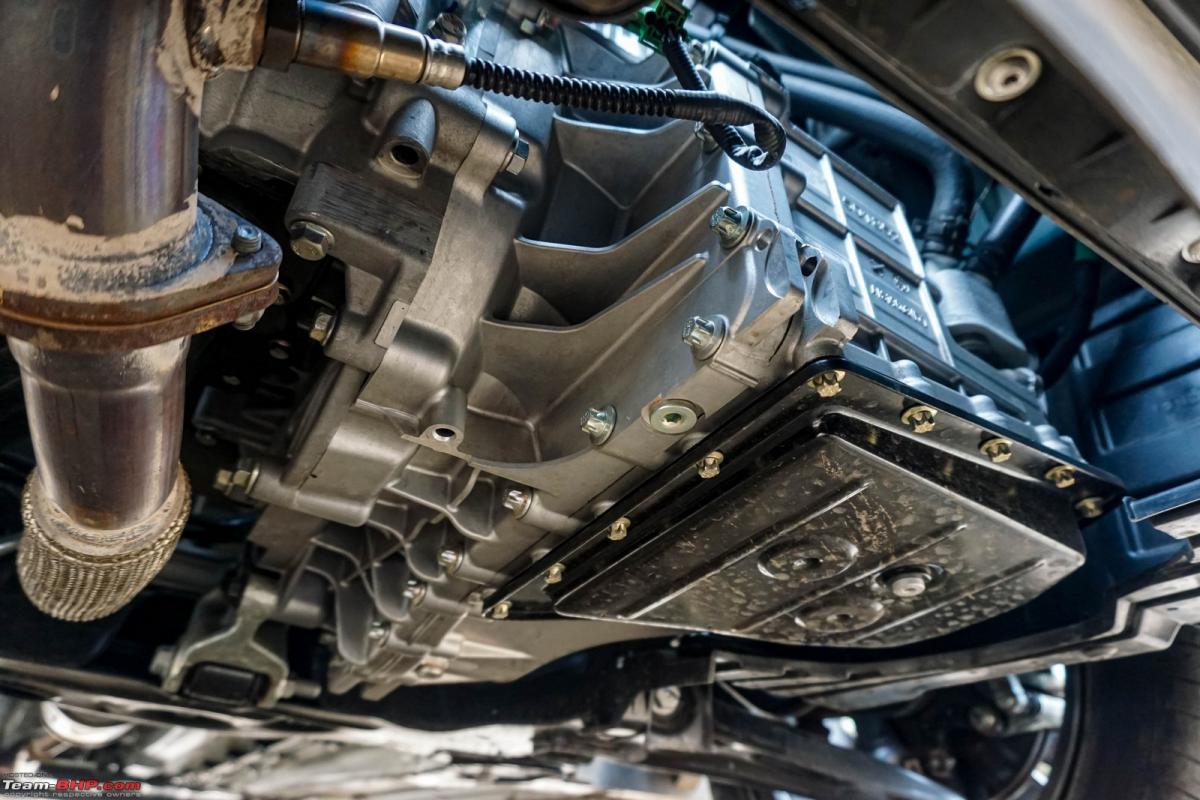
If the car comes to a halt on an incline, the driver takes off his seatbelt, the gear shifter is in "N" position, the brake pedal is not pressed and the driver's door is opened, the car will sense that the handbrake is not engaged and to prevent the car from rolling backwards, the transmission will engage "park lock", which stops the car in its tracks. The MID will display "Auto Park Activated" and will ask you to engage the handbrake. Could save a careless driver from a bad crash:
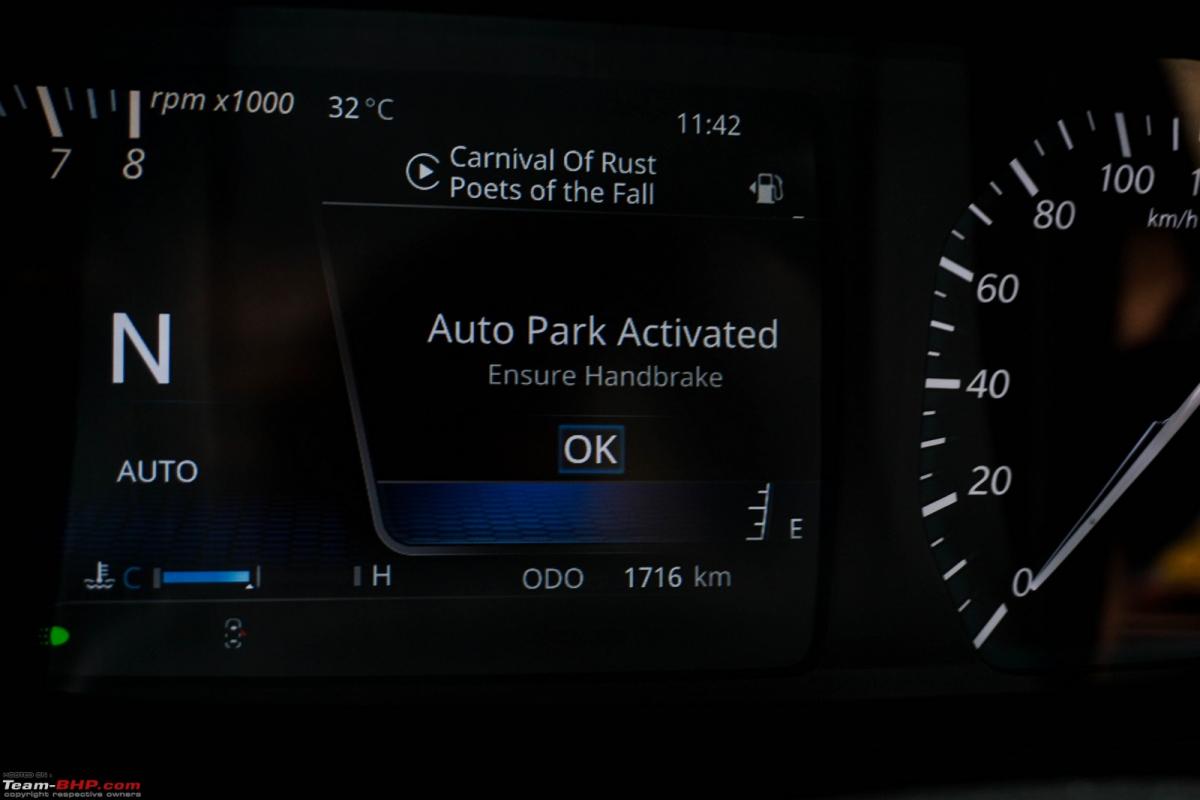
MID asks you to shift to "P" when you turn off the vehicle in other gears:

In manual mode, if you try to downshift when the revs are too high or try to upshift when the revs are too low, the MID tells you clearly that your command is rejected! We didn't find the conservatively-tuned manual mode to be of much use here and preferred driving in full-auto mode only:

Suspension
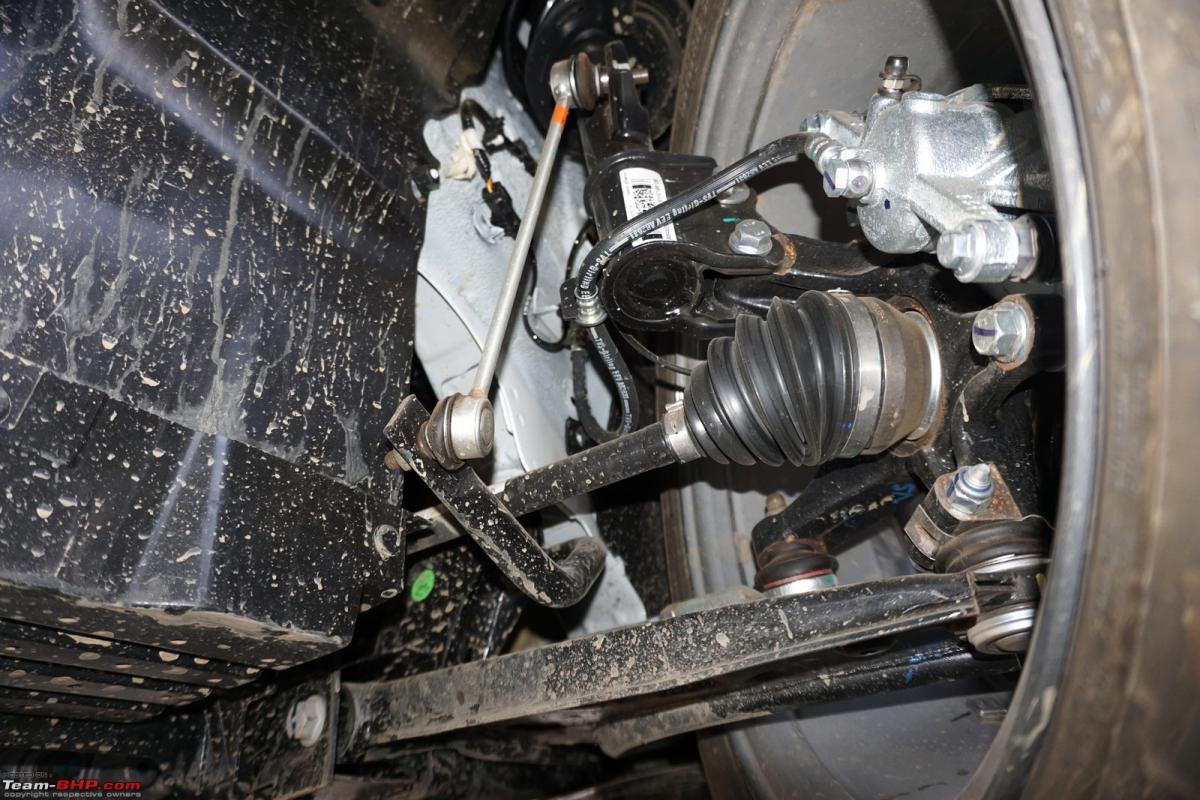
Ride Comfort
The Altroz is equipped with an independent McPherson strut dual-path front suspension and twist-beam rear. The dual-path strut has two separate paths for energy to be transferred from the springs & dampers, allowing it to be better tuned (it's a 2-cup system).
The Altroz's suspension has a mature tune and is kind of European car-like in nature. At low speeds, the ride has a firm edge to it. It's not all soft & plush, yet compliant nevertheless. Big potholes will be felt inside though. Another contributor is the 16" wheel size of the DCA. Unlike the MT, there are no variants with smaller wheels & taller tyres. As speeds increase, that mature suspension results in good ride quality. On the expressway, there is no bounciness - she rides quite flat. Firmer suspension tunes also recover well from road undulations. On the highway, the Altroz handles broken roads decently and dismisses smaller potholes with aplomb. Most of the time, the suspension goes about its job silently and isn't clunky or loud.
Handling & Dynamics
Straight-line stability is exceptional and the Altroz drives like a "big car" on the expressway. There is no floatiness or nervousness at all. The car is well-planted with superb high-speed manners. The 185/60 R16 Goodyear Assurance tyres provide fair grip levels for an average Joe. Enthusiastic drivers might want to swap to grippier tyre models. The Altroz holds onto its line well and doesn't understeer easily. Body roll is controlled and the car never gets unnerving. But again, we felt that the Altroz 1.2L NA lacks the sort of power to unsettle it in corners. Hope to see this DCA in the more powerful motors soon.
Steering
The electric power steering is one of the nicer units around. That thick steering wheel is a delight to hold. It is light at city speeds (one-finger-light at parking speeds) and weighs up sufficiently well as the speedometer needle climbs. The EPS isn't dead and does give you some feel of what the front wheels are up to.
Braking
We found the brakes to be progressive and doing the job as expected. They have cornering stability control too (Tata says "CSC supports / stabilizes the vehicle during partial braking in curves by reducing pressure at the required inner wheel. This helps to reduce the probability of vehicle oversteer during cornering + braking"). From high speeds, the car stops in a straight line sans any drama.
Niggles & Problems
This dual-clutch transmission in the Altroz seems impressive in terms of technology. However, there's no denying the fact that it's a complex gearbox & DCTs have never proven reliable in India, whether from VW-Skoda, Ford or even Hyundai-Kia. We sure hope this gearbox doesn't face any of the problems that some of the other DCTs in India have seen. The standard warranty is of 2 years / 75,000 km. Extended warranty is available for up to 3 years / unlimited km and we strongly recommend getting it.
Continue reading the discussion on the 2022 Tata Altroz DCA on our forum.
- Tags:
- Indian
- Review
- Altroz
- Altroz DCA
Pages



